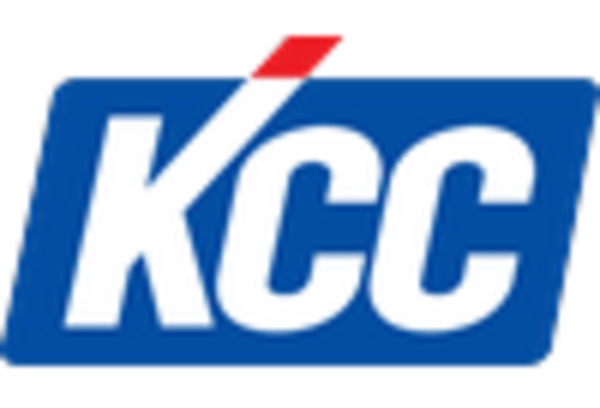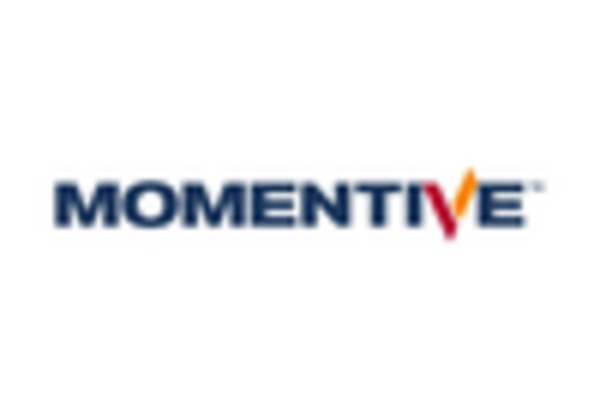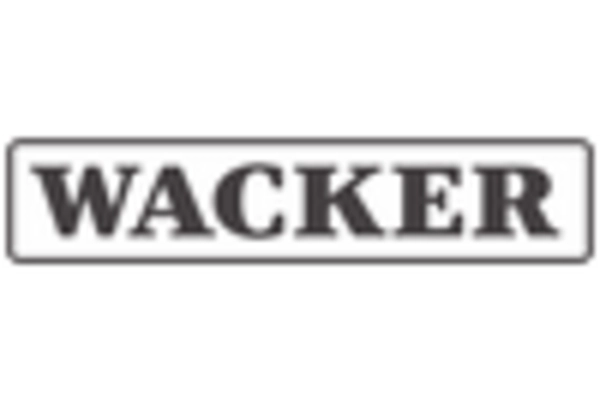Growth in Consumer Electronics
The consumer electronics sector in North America is rapidly evolving, with silicone rubber playing a pivotal role in the production of various devices. The silicone rubber market benefits from the increasing demand for smartphones, wearables, and smart home devices, which require materials that can withstand wear and tear while providing aesthetic appeal. The market for consumer electronics is expected to grow at a CAGR of 5.5% through 2026, indicating a robust opportunity for silicone rubber applications in protective casings, keypads, and connectors. As manufacturers seek to enhance product durability and user experience, the silicone rubber market is likely to see a corresponding increase in demand, driven by innovation and consumer preferences for high-quality, resilient materials.
Rising Demand in Automotive Sector
The automotive sector in North America is experiencing a notable surge in demand for silicone rubber, primarily due to its superior properties such as heat resistance, flexibility, and durability. As vehicle manufacturers increasingly prioritize lightweight materials to enhance fuel efficiency, silicone rubber emerges as a preferred choice. The silicone rubber market is projected to witness a growth rate of approximately 6% annually, driven by the integration of silicone components in various automotive applications, including seals, gaskets, and insulation. Furthermore, the shift towards electric vehicles (EVs) is likely to further bolster this demand, as silicone rubber is essential for battery encapsulation and thermal management systems. This trend indicates a robust future for the silicone rubber market, as automotive manufacturers continue to innovate and adapt to changing consumer preferences.
Expansion of Healthcare Applications
The healthcare sector in North America is increasingly adopting silicone rubber due to its biocompatibility and resistance to extreme temperatures. The silicone rubber market is witnessing a significant uptick in demand for medical devices, including catheters, seals, and surgical instruments. With the market for medical devices projected to reach $208 billion by 2025, the role of silicone rubber becomes crucial in ensuring product safety and efficacy. Additionally, the ongoing advancements in healthcare technology, such as telemedicine and remote monitoring, are likely to drive further innovation in silicone-based products. This expansion in healthcare applications not only enhances the silicone rubber market but also underscores the material's versatility and reliability in critical medical environments.
Infrastructure Development Initiatives
Infrastructure development in North America is gaining momentum, with significant investments being made in construction and renovation projects. The silicone rubber market stands to benefit from this trend, as silicone materials are increasingly utilized in construction applications such as sealants, adhesives, and expansion joints. The construction sector is projected to grow by 4% annually, driven by government initiatives aimed at improving public infrastructure. This growth presents a substantial opportunity for the silicone rubber market, as the demand for durable and weather-resistant materials becomes paramount in ensuring the longevity and safety of infrastructure projects. The versatility of silicone rubber in various environmental conditions further enhances its appeal in this sector.
Innovations in Manufacturing Processes
The silicone rubber market is witnessing a transformation due to innovations in manufacturing processes, which enhance efficiency and reduce costs. Advanced techniques such as 3D printing and injection molding are being adopted, allowing for more precise and customizable silicone products. This shift is particularly relevant in industries such as automotive and consumer goods, where rapid prototyping and production flexibility are essential. The market is expected to see a growth rate of 5% annually as manufacturers leverage these innovations to meet the increasing demand for specialized silicone rubber products. Furthermore, the emphasis on sustainability in manufacturing processes may lead to the development of eco-friendly silicone materials, further propelling the silicone rubber market into a new era of growth.
















Leave a Comment